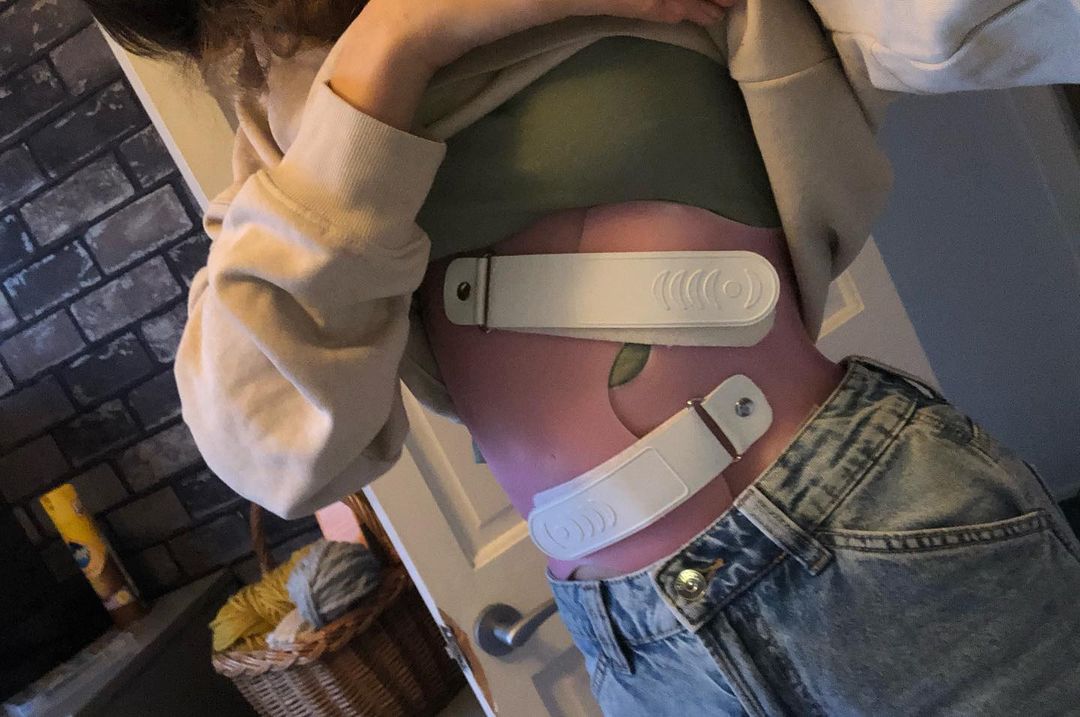
Flo wearing her bespoke pink scoliosis brace from the London Orthotic Consultancy.
26 June 2023
When Flo was 12, her mum Vicky noticed that she had asymmetrical hips that did not match. She didn’t think much more about it until her own mother said, “Have you seen her back?” after noticing a little curve in her lower spine.
Vicky, who is a mental health nurse, immediately sent off a photo to the family GP and Flo was referred to Evelina Children’s Hospital in October 2021 which confirmed a diagnosis of adolescent idiopathic scoliosis. ‘Idiopathic’ meaning there is no known cause. At that time, Flo’s Cobb angle (which is a measure of the degree of spinal curve) was 16 degrees.
A Cobb angle between 10 to 20 degrees is considered mild scoliosis. When the Cobb angle ranges from 20 to 40 degrees it is described as moderate and anything above 40 degrees is considered severe.
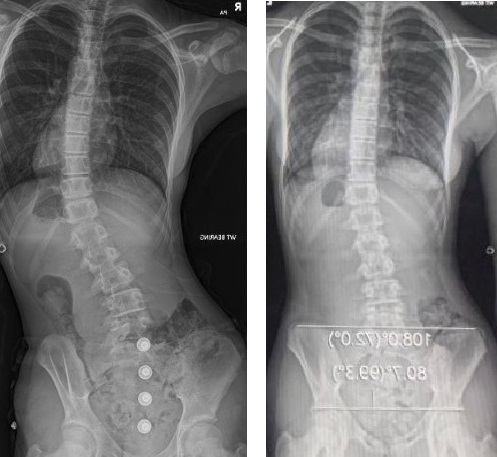
Before and after images show Flo’s x-rays from the start of her treatment (left) and at the end of her treatment with her first brace (right). Both x-rays are taken out of brace.
The hospital advised taking a ‘wait and see approach,’ as Flo was just outside the Scoliosis Research Society’s bracing criteria guidelines. But Vicky was worried, “Flo was going through a tremendous growth spurt, and I just knew that her curve would get worse”.
Since a young child's skeletal system is still developing and can undergo significant growth spurts during puberty, their scoliosis has the potential to drastically increase during these periods of rapid growth. And the more a child grows, the higher the likelihood that their spinal curve will worsen. It was around this time that Vicky contacted LOC and had an initial virtual consultation with Anna Courtney, LOC’s scoliosis lead, in October 2021.
Vicky recalls: “Anna has been amazing; she was always available to talk to me even before Flo was a patient. It was very useful to have her as a sounding board as I continued to battle with the hospital to prescribe Flo a brace. My worst fears were confirmed when her next scan showed her Cobb angle had increased to 24 degrees and that was in just three months.”
The hospital continued to refuse to brace Flo, but mum Vicky was concerned and booked her a face-to-face appointment with Anna in March 2022. By that time, Flo’s Cobb angle had increased to 34.3 degrees. At LOC we are extremely aware of how time sensitive non-surgical treatment for scoliosis is. Flo’s bespoke LOC scoliosis brace was fitted just a week later.
Flo continued to be in the care of the Hospital and at her next appointment Vicky was told by the spinal surgeon that the Cobb angle had been reduced to 22.4 degrees. During the appointment, they admitted that Vicky had been correct in sticking to her guns and insisting on going down the bracing route.
Vicky concludes “My obvious, only regret is that I didn’t start bracing with LOC earlier.”
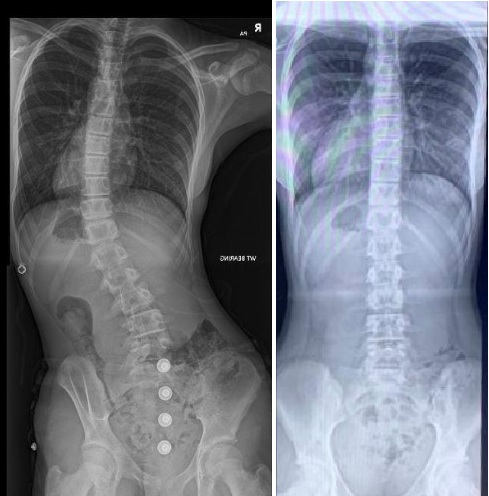
A follow-up scan in July shows that after just 16 months of wearing the brace, her spine is now totally straight, with no scoliosis present.
Some mild cases of scoliosis may self-correct as a child grows, but this is not always the case with adolescent idiopathic scoliosis. However, it is important that any existing curvature is monitored closely to check progression, particularly during rapid growth spurts during puberty.
If you think your child may have scoliosis but are not sure what to do, we can provide clinical assessments and refer your child for any necessary x-rays or scans required. These scans help us determine the progression factor, which is the incidence of progression of untreated idiopathic scoliosis according to the formula by Lonstein and Carlson (see graph below). It can help us determine the recommended treatment for each patient. The skeletal maturity and age of the individual also affects the recommended treatment plan.
As Flo’s case proves, scoliosis can progress quickly while the skeleton is still growing or during hormonal changes so if you are concerned about your child, please contact us.
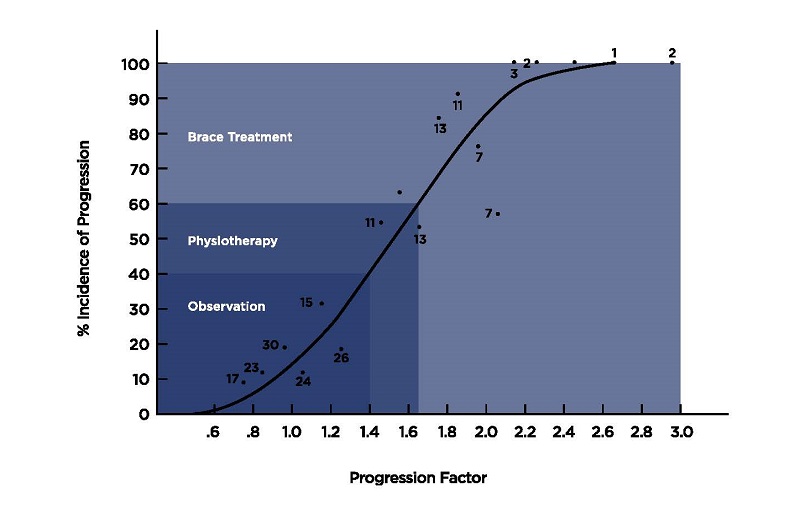
Calculating progression factor for scoliosis, which is the incidence of progression of untreated idiopathic scoliosis, according to the formula created by Lonstein and Carlson.
We offer a free initial virtual scoliosis appointment for those seeking scoliosis advice and treatment. This initial free virtual consultation is carried out through Skype, Facetime or Zoom.
This gives you the opportunity to talk directly to one of our specialist clinicians about your child’s scoliosis. During this 15-minute appointment, your clinician will be able to answer any detailed questions or concerns you might have prior to booking a face-face assessment with us.
If your child has recently been diagnosed with scoliosis or you think they are showing signs of the condition, please get in touch to book an appointment today.
Scoliosis is a condition where there is an abnormal curvature of the spine. It is a three-dimensional condition with deviation of the vertebrae in the sagittal, coronal and transverse planes.
Treatment recommendations are based on the Cobb angle of the patient and the risk of progression. For curves under 20 degrees, we monitor the patient’s curve while the patient undertakes a tailored exercise programme based on Schroth principles; this is delivered by our partner in providing scoliosis treatment, Scoliosis SOS.
For curves above 20 degrees, we prescribe our LOC Scoliosis Brace which works three-dimensionally to guide the patient’s spine into a more correct position, substantially reducing their Cobb angle. For optimum correction, we recommend that bracing is combined with specialist physiotherapy.
This joint approach means our patients are getting the best and most appropriate advice from two scoliosis specialists, one with an orthotic perspective and one with a physiotherapy perspective.
LOC makes the vast majority of orthotics we fit, and our scoliosis brace is no exception. It is difficult to over-emphasize how important it is to have our own manufacturing unit on site. Lead times are shorter because we are not reliant on outside suppliers, and we can fine-tune our braces at the fitting stage to ensure optimum efficacy and comfort.
The LOC Scoliosis Brace is a 3D, hypercorrective, Cheneau-Gensingen derivative brace, known as one of the most corrective and modern scoliosis braces available in the UK. It is designed to:
The brace is entirely unique and tailored to the patient’s spinal curve pattern, ensuring optimal skeletal correction while prioritising comfort.
Unlike traditional braces, it opens from the front for easier self-application and maintains a low profile under clothing.
The LOC Scoliosis Brace is worn 22 hours a day (including nighttime) and works in conjunction with Schroth-based therapy for maximum results.
Typically, there is an initial consultation followed by a fitting appointment and then pre- and post-reviews after in-brace x-rays; thereafter reviews every three months until the end of treatment. For the majority of our patients who are adolescents, we believe it is essential that there are regular assessments and reviews to ensure that the brace is fitting well; we will make tiny adjustments to the brace to ensure optimum comfort and optimum correction. We have found that comfort is a major contributor to an individual’s compliance with the prescribed wearing regime. In addition, the close contact between patient and clinician ensures patient motivation resulting in better outcomes at the treatment end.
We are pleased to offer a free-of-charge, virtual assessment should you wish to be screened for scoliosis. If we feel a referral to an Orthopaedic Consultant is warranted, we recommend a consultation at The Wimbledon Clinic, Parkside with Mr Darren Lui, Mr Jason Bernard or Mr Tim Bishop. The consultant would arrange the imaging as required. Obviously, you can also seek advice from your family GP.
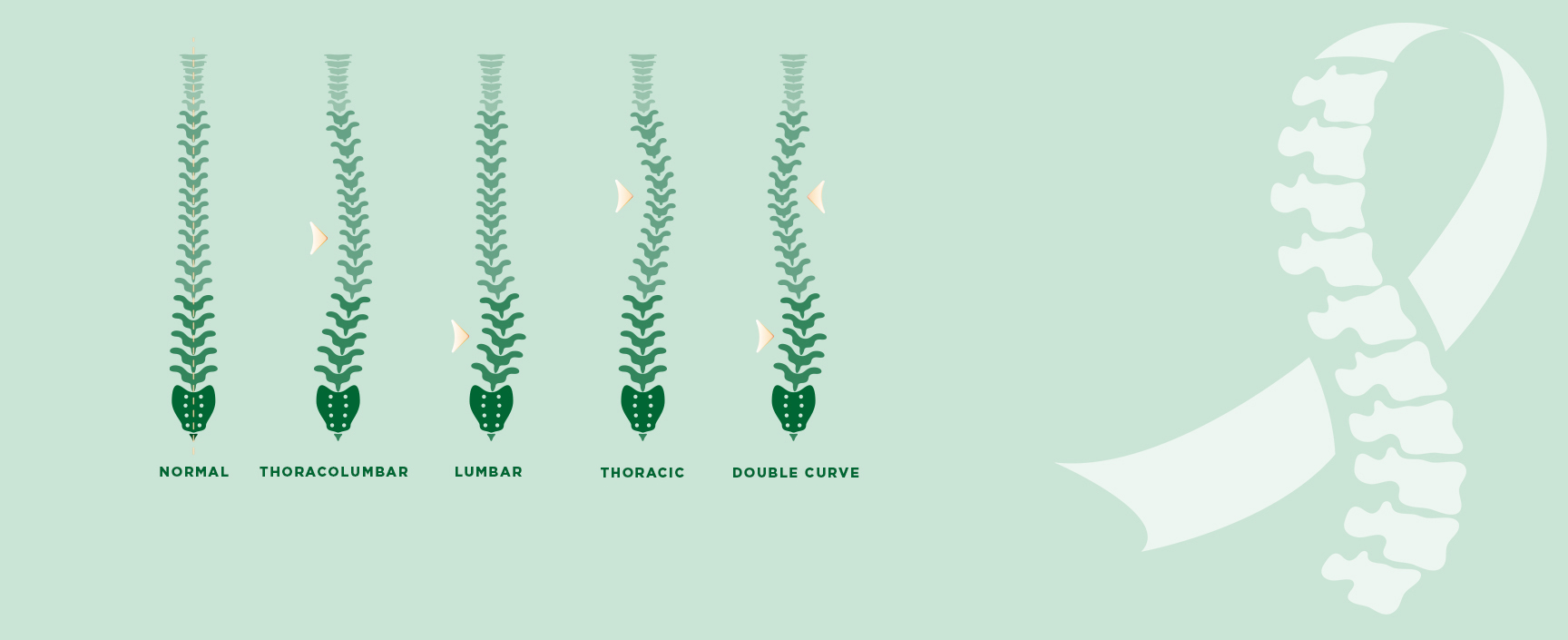
We've Got Your Back - Embracing Scoliosis Awareness Month at LOC